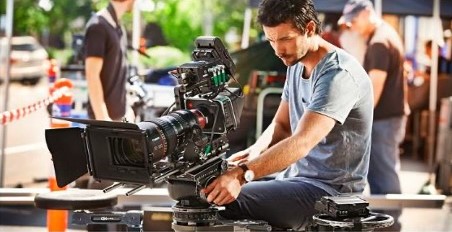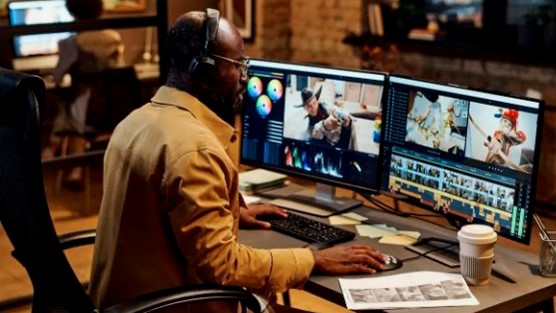Some may think that the use of AI in the media and entertainment industry (and other areas) is a universal solution for making everything easier to use and accomplish, with better results than humans can accomplish on their own accord. Others see it as the root of all evil, taking our jobs, making people lazy, creating havoc and strife, and basically destroying all of mankind bit by bit and byte. And then there are those moderates, and many would argue, the more reasonably-minded, who see the benefits of AI albeit with a watchful eye. They do not see it as a panacea for everything. Rather, they take the tack of using AI where it improves workflow, workload, and entertainment value.

“An AI is like any intelligence. It has needs. It will start to evolve, to influence perhaps the entire world.” –Max Waters, Transcendence, Warner Bros., 2014
We were asked how much AI we used in doing our weekly screed. Honestly, none. We have a general idea as we write, but our mind tends to wander, “Oh look at the cute birdie!” Sometimes we hit a dead end, hit delete, and start over… again. But, when we’re finally satisfied, we can say, “Yeah, we did that.”
We know AI is creeping into every segment of the M&E industry—some scary good, some scary bad. It will grow in usage in ways we can’t even imagine, so writing guardrails into contracts and then bragging about them doesn’t do much good because things change, stuff happens.
There is a lot of euphoria surrounding all the good/great things AI is going to do for us. We still aren’t sure of the side effects. Still, we’re cautiously optimistic about the use of AI technology in the industry. Some applications show promise in reducing costs, reducing inefficiencies, improving the quality and quantity of projects, and streamlining the delivery/viewer satisfaction processes. Nevertheless, the relationship needs to develop slowly, because we’ve already seen half-baked ideas released into the wild, and once they’re out there, they’re out there. We’re not a complete luddite, but we just don’t recall an AI movie that turned out well.
The tech-based streamers and producers have been using the technology for some time to wade through tons of movie and show ideas, viewer response, and fiscal results to determine what works and what doesn’t. A lot of “great” film story ideas never make it past this hurdle, disappointing folks who just “knew” this project was right and people would flock to see it.
At other times, the data will be used to change and refine ideas and word/action flow to strengthen the film or show. In many instances, the ideation creators will agree that the recommendations did improve the project. After all, no one wants to be associated with a dud, even if the person isn’t on the credits.
As Netflix co-CEO Ted Sarandos noted during the company’s last earnings report, people ultimately care most about the quality of the show or movie rather than the technology being used.
To deliver a constant stream of new content, the leading film/show providers in the Americas will be investing a total of $133 billion out of the global investment of more than $247 billion.
Hollywood/LA still represents the major center in the content world; but thanks to studio construction, tax incentives, and advances in training and tools, great projects are being produced in Atlanta, Tucson, Albuquerque, Toronto, London, Berlin, Lagos, Mumbai, Seoul, and other major film centers. This as studios/streamers are finding it easier and more economic to develop, produce, and acquire content that people really want to see from around the globe. And, according to PwC, film/show production in the Americas will increase 4.3% through 2028, which is behind the global rate of 4.6%.
One of the greatest advances (in our opinion) was VP (virtual production), a combination of technologies developed by Disney’s Industrial Light & Magic (ILM), gaming kingpin Nvidia’s GPUs, and Epic Games’ Unreal Engine gaming software. Production studios continue to be built around the worldwide, with at least one stage dedicated to virtual production, enabling creators to digitally duplicate locations anywhere. And, they are not just for major projects any longer.
The advance has virtually eliminated the use of greenscreen production. For a studio to competitively land film/show projects, VP is almost a necessity. The virtual production stage enables the production and postproduction teams to work together efficiently and seamlessly. VP and the enhanced computing power leveled the playing field for studios everywhere to compete for film/show production and has almost eliminated the need and expense of location shoots. While it hasn’t necessarily reduced the long hours crews spend on set, it does enable them to periodically get home at a reasonable hour.
But long before projects hit the set, something has to be written. AI is being cautiously used in film/show writers’s rooms to assist in researching ideas and subjecting options, but it still takes empathy and experience to develop scripts that grab and hold an audience’s interest and attention.As many might recall, AI content development and generation were key factors in last year’s writers strike and will be used to assist creators (writer’s assistances, script coordinators, staff writers/editors and showrunners) in translating concepts into stories and generating credible human dialog. Increasingly, it will be used to turn text into visuals and storyboards and create animated 3D models from 2D videos or images.
Most of the focus today is on speed, efficiency, and reducing costs, and the industry has yet to define and determine how the powerful technology can produce greater value creation. The common concern in the industry is that AI will replace jobs; and in some instances, this may be true. But from what we’ve seen to date and the developments that are in the works, we also agree with AI proponents’s observations that AI won’t replace your job, although somebody using AI will take your job.

That being said, it stands to reason that AI will impact the “management” layer more so and put more power in the hands of creatives who have experience in delivering compelling video stories. AI is already proving its value in storyboarding and previsualization, allowing for rapid prototyping and visualizing scenes before they are shot. Advanced smart camera tracking makes it possible to lock onto targets while shooting scenes, and at the same time, being able to analyze and recommend alternative camera shots and angles. A major advantages of these new AI-controlled systems is that they reduce the chances of human error during shooting to get the perfect show every time. In addition, they can increase shooting time and productivity.
In many ways, AI enhances film/show creativity by enabling filmmakers and crews to envision and create content that would have been difficult and perhaps even impossible before.
You have probably noticed the dramatic number of really great animated projects from studios in the Americas and especially Southeast Asia. Many of these would have been budget (time, money) prohibitive in the days of hand-drawn animation. AI and CGI have not only made animation for games and video stories less expensive and faster, but have also increased the number of jobs in the field. The same is true in film/show postproduction. By automating many of the mundane, time-consuming tasks, they give video and sound editors, colorists, VFX specialists, and artists the ability to focus on higher-level tasks.

Adobe Creative Cloud, Blackmagic Design DaVinci Resolve, Apple Final Cut Pro, Avid Pro Tools, and other solutions have cautiously and effectively introduced cutting-edge AI tools into the industry’s postproduction processes. Adobe Firefly is a comprehensive suite of generative AI tools that don’t just manipulate images and video but also perform automatic B-roll generation with advanced editing options in addition to smoothing transitions, extending shots, and more. Adobe Premiere Pro, coupled with the firm’s Creative Cloud apps, multi-cam editing capabilities, automatic VR orientation, and other enhancements have made it a popular solution across the postproduction arena. Widely used in studio production, Avid Media Composer has been enhanced with collaborative workflow, multiple-resolution support and real-time collaboration. Designed for large projects, Avid’s solutions enable frame-accurate editing, advanced color grading, and HDR support.
A solution that has continued to amaze us is Blackmagic’s DaVinci Resolve. The company has steadily improved its capabilities and performance with high-quality color grading tools, high-resolution/frame rate support, automatic image stabilization, cinematic-quality visual effects, and surround sound audio mixing support.
When combined with video analytics software, these tools help the production/post team to quickly, efficiently, and effectively scan through the volumes of video files (sometimes 20TB–50TB or more) to find the best angles and shots for a completed film or show. When content production moved from film to digital, the amount of content shot and captured literally went through the roof and shot/scene selection became time consuming, labor intensive, and most post folks will say downright mind-numbing. AI-enabled video analytics tools didn’t make the job fun, but they did enable the production/post team to create high-quality content more quickly.
One of the areas where AI has probably impacted jobs is in movie/show localization. With advanced AI-enabled localization products, studios/streamers can more quickly, more effectively, and more economically meet the interests and enjoyment needs of people around the world. Historically, content produced in India, Japan, South Korea, France, or any other country was produced in a specific language for a specific audience. That was it!
A little hint here, if you’re visiting another country, any country, go to a movie (or two). It’s a great way to learn how to converse with locals—they’ll appreciate it, and you’ll enjoy your trip a whole lot more.
Allan McLennan, CEO of 2G Digital, noted that localization used to require hours of people painstakingly translating the audio into something folks in the target market could understand. The fastest and most expensive approach are subtitles, which even producer Bong Joon-ho used for his Oscar-winning film Parasites. He referred to it as the 1-inch subtitle barrier because it is the least expensive and most widely used way to localize a film or show.
“Even with advanced AI tools we use today on films/shows, it is still time and process intensive to dub a project, but it is a lot more economical,” McLennan stated. “Few studios or producers would consider the daunting task of accurately lip-synching the words with people’s faces. But using AI-enabled tools, producer James Cameron was able to localize Avatar 2 into 47 languages.”
McLennan pointed out that today, Netflix, Amazon Prime, Apple TV+, and most of the studios now acquire and produce projects around the world for viewing in the countries where they have subscribers. Increasingly, they’re finding that the films and shows develop significant followings around the globe.
“Video stories have always transcended country borders,” McLennan emphasized, “but AI localization just made it easier and more fun for folks to enjoy.”

That’s true, but there’s one AI-enabled tool we really appreciate, and that’s Netflix’s recommendations system. Sure, we know that they use all the information they gather from us to develop/acquire “gotta watch films/shows” in addition to “suggesting” why we can’t afford to leave them. It’s not the only one that helps people pinpoint stuff they’d like to watch, but it’s our go-to favorite when it comes to finding projects we might (will probably) enjoy. Apple and Disney+ have good selection engines based on our viewing experience and habits, but most of the others have a recommendation/selection tool that’s a “work in progress.”
Jeez, guys, wake up and copy what the industry leaders do. How difficult can it be?
Studios, indie filmmakers, and streamers still have a lot of work to do to ensure they use AI right and when to leave the work to the experts. It’s not as easy as tech proponents would have you believe. Obviously, it’s more difficult than we think. AI tools and products are still in their infancy, but we think most of them are products that need to be examined, tested, and learned from before they’re released in the real world.
The technology pushers need to take a page from the first computer algorithm developer, Ada Lovelace, when she said back in 1843, “Never am really satisfied that I understand anything; because, understand it well as I may, my comprehension can only be an infinitesimal fraction of all I want to understand about the many connections and relations which occur to me.”
AI has the potential of being the productivity engine for creative processes. And as Will Caster noted in Transcendence,“Actually, it’s still in its infancy. What you’re seeing is just a small taste of what we’ll achieve.”
AI is still in the nascent stage and can be used to do both good and bad.